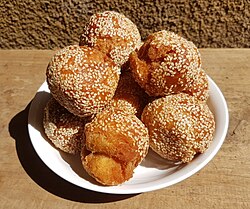 | |
| Alternative names | kabak |
|---|---|
| Course | Snack |
| Place of origin | Philippines |
| Region or state | Visayas, Mindanao |
| Serving temperature | Warm, room temperature |
| Main ingredients | flour, baking powder, baking soda, sugar, egg or evaporated milk, sesame seeds |
Binangkal is a type of doughnut from the islands of Visayas and Mindanao in the Philippines. It is made from deep-fried dense dough balls coated with sesame seeds. [1] [2] [3] It is usually eaten with hot chocolate or coffee. [4]
The name is derived from bangkal, the local Cebuano common name for the Leichhardt tree ( Nauclea orientalis) which bears spherical flowers and fruits. [5]
See also
References
- ^ Dawn Bohulano Mabalon (2013). "As American as Jackrabbit Adobo: Cooking, Eating, and Becoming Filipina/o American before World War II". In Robert Ji-Song Ku; Martin F. Manalansan; Anita Mannur (eds.). Eating Asian America: A Food Studies Reader. NYU Press. p. 169. ISBN 9781479869251.
- ^ Belle Piccio (August 6, 2013). "Binangkal: A Cebuano Native Delicacy". Choose Philippines. Retrieved December 2, 2016.
- ^ "Binangkal Recipe". Kusinera Davao. Archived from the original on June 7, 2019. Retrieved December 2, 2016.
- ^ Bernadette Parco (September 15, 2016). "'Hikay': Cookbook hopes to keep Cebuano cookery alive". GMA News Online. Retrieved December 2, 2016.
- ^ "Bangkal". Binisaya.com. Retrieved December 2, 2016.
External links
 | |
| Alternative names | kabak |
|---|---|
| Course | Snack |
| Place of origin | Philippines |
| Region or state | Visayas, Mindanao |
| Serving temperature | Warm, room temperature |
| Main ingredients | flour, baking powder, baking soda, sugar, egg or evaporated milk, sesame seeds |
Binangkal is a type of doughnut from the islands of Visayas and Mindanao in the Philippines. It is made from deep-fried dense dough balls coated with sesame seeds. [1] [2] [3] It is usually eaten with hot chocolate or coffee. [4]
The name is derived from bangkal, the local Cebuano common name for the Leichhardt tree ( Nauclea orientalis) which bears spherical flowers and fruits. [5]
See also
References
- ^ Dawn Bohulano Mabalon (2013). "As American as Jackrabbit Adobo: Cooking, Eating, and Becoming Filipina/o American before World War II". In Robert Ji-Song Ku; Martin F. Manalansan; Anita Mannur (eds.). Eating Asian America: A Food Studies Reader. NYU Press. p. 169. ISBN 9781479869251.
- ^ Belle Piccio (August 6, 2013). "Binangkal: A Cebuano Native Delicacy". Choose Philippines. Retrieved December 2, 2016.
- ^ "Binangkal Recipe". Kusinera Davao. Archived from the original on June 7, 2019. Retrieved December 2, 2016.
- ^ Bernadette Parco (September 15, 2016). "'Hikay': Cookbook hopes to keep Cebuano cookery alive". GMA News Online. Retrieved December 2, 2016.
- ^ "Bangkal". Binisaya.com. Retrieved December 2, 2016.

